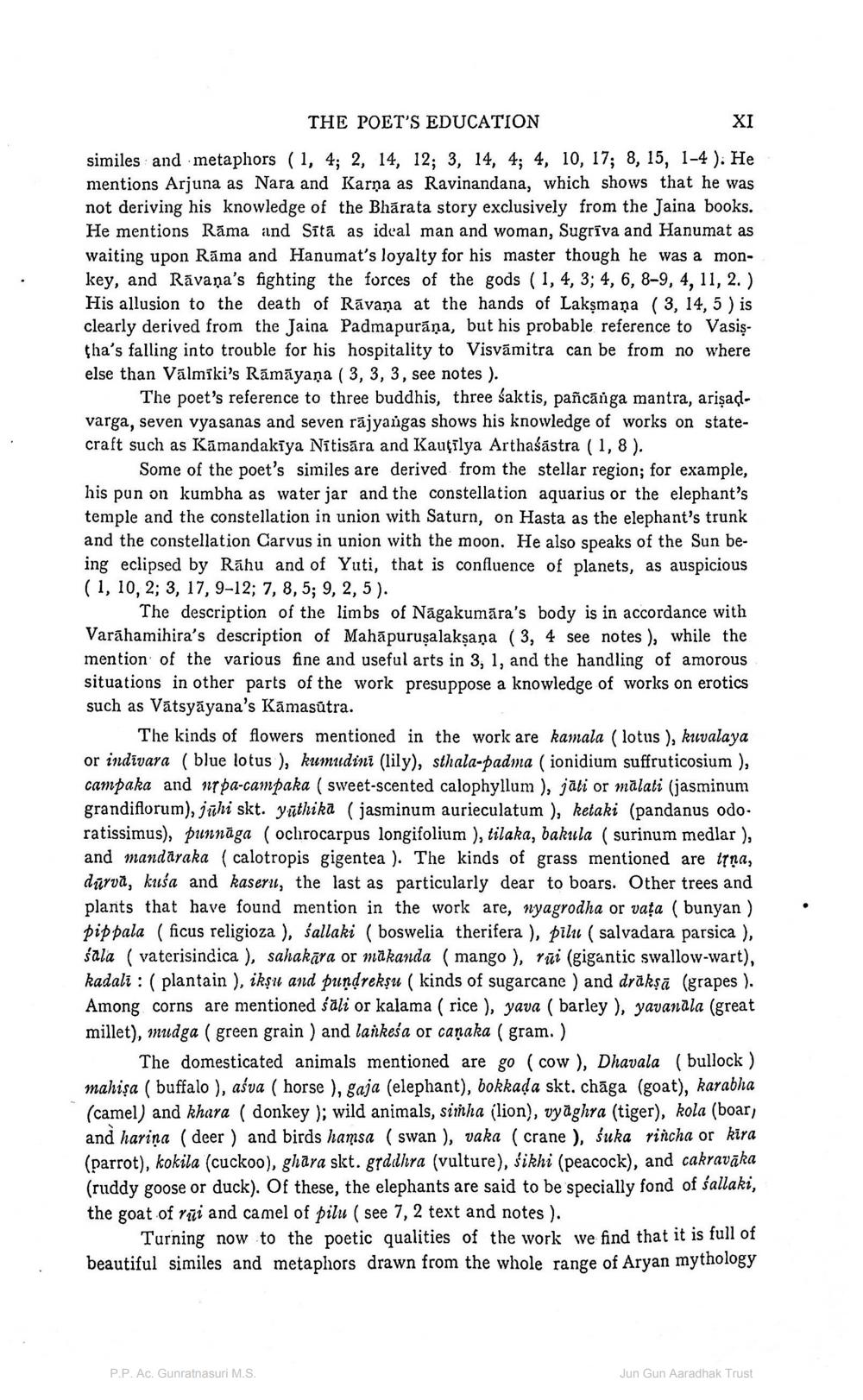________________ THE POET'S EDUCATION XI similes and metaphors (1, 4; 2, 14, 12; 3, 14, 4; 4, 10, 17; 8, 15, 1-4 ). He mentions Arjuna as Nara and Karna as Ravinandana, which shows that he was not deriving his knowledge of the Bharata story exclusively from the Jaina books. He mentions Rama and Sita as ideal man and woman, Sugriva and Hanumat as waiting upon Rama and Hanumat's loyalty for his master though he was a monkey, and Ravana's fighting the forces of the gods ( 1, 4, 3; 4, 6, 8-9, 4, 11, 2. ) His allusion to the death of Ravana at the hands of Laksmana (3, 14,5 ) is clearly derived from the Jaina Padmapurana, but his probable reference to Vasistha's falling into trouble for his hospitality to Visvamitra can be from no where else than Valmiki's Ramayana (3,3,3, see notes ). The poet's reference to three buddhis, three saktis, pancanga mantra, arisadvarga, seven vya sanas and seven rajyangas shows his knowledge of works on statecraft such as Kamandakiya Nitisara and Kaucilya Arthasastra (1,8). Some of the poet's similes are derived from the stellar region; for example, his pun on kumbha as water jar and the constellation aquarius or the elephant's temple and the constellation in union with Saturn, on Hasta as the elephant's trunk and the constellation Carvus in union with the moon. He also speaks of the Sun being eclipsed by Rahu and of Yuti, that is confluence of planets, as auspicious ( 1, 10, 2; 3, 17, 9-12; 7, 8,5; 9, 2, 5). The description of the limbs of Nagakumara's body is in accordance with Varahamihira's description of Mahapurusalaksana (3, 4 see notes ), while the mention of the various fine and useful arts in 3, 1, and the handling of amorous situations in other parts of the work presuppose a knowledge of works on erotics such as Vatsyayana's Kamasutra. The kinds of flowers mentioned in the work are kamala ( lotus ), kuvalaya or indivara (blue lotus ), kumudini (lily), sthala-padma ( ionidium suffruticosium ), campaka and nt pa-campaka ( sweet-scented calophyllum ), jati or malati (jasminum grandiflorum), juhi skt. yathika (jasminum aurieculatum ), ketaki (pandanus odo. ratissimus), punnaga (ochrocarpus longifolium ), tilaka, bakula surinum medlar ), and mandaraka ( calotropis gigentea ). The kinds of grass mentioned are tina, durva, kusa and kaseru, the last as particularly dear to boars. Other trees and plants that have found mention in the work are, nyagrodha or vaga (bunyan ) pippala (ficus religioza ), sallaki ( boswelia therifera ), pilu ( salvadara parsica ), sala (vaterisindica ), sahakara or makanda (mango ), rui (gigantic swallow-wart), kadali : (plantain ), iksu and pundreksu ( kinds of sugarcane ) and draksa (grapes ). Among corns are mentioned sali or kalama (rice ), yava ( barley ), yavanala (great millet), mudga ( green grain ) and lankesa or canaka ( gram. ) The domesticated animals mentioned are go (cow), Dhavala (bullock ) mahisa ( buffalo ), asva ( horse ), gaja (elephant), bokkada skt. chaga (goat), karabha (camel) and khara ( donkey ); wild animals, simha (lion), vyaghra (tiger), kola (boar) and harina (deer ) and birds hamsa ( swan ), vaka ( crane ), suka rincha or kira (parrot), kokila (cuckoo), ghara skt. grdilhra (vulture), sikhi (peacock), and cakravaka (ruddy goose or duck). Of these, the elephants are said to be specially fond of sallaki, the goat of rai and camel of pilu ( see 7, 2 text and notes ). Turning now to the poetic qualities of the work we find that it is full of nd metaphors drawn from the whole range of Aryan mythology P.P.AC. Gunratnasuri M.S. Jun Gun Aaradhak Trust




